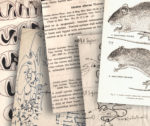Micromamíferos y paleoambientes durante el Holoceno tardío en el noreste de Patagonia (Río Negro, Argentina)
Fernando J. Fernández, Emiliano Mange, Luciano PratesEn este trabajo se realiza un análisis integral de la información taxonómica y paleoambiental de los conjuntos de micromamíferos recuperados en sitios arqueológicos ubicados en el valle medio del río Negro y áreas próximas hacia el sur (noreste de Patagonia). Se incluyen, como parámetro actual, muestras de micromamíferos (mayormente novedosas) de egagrópilas de aves rapaces recolectadas en el área. La matriz general de los conjuntos de micromamíferos del valle medio del río Negro muestra condiciones áridas propias del Monte durante los últimos 1000 años AP. No obstante, la presencia de Holochilus vulpinus en los ríos Negro y Limay posiblemente responda a su avance durante episodios algo más cálidos y húmedos del Holoceno, con una ulterior retracción durante la Pequeña Edad de Hielo. Por otro lado, los conjuntos de micromamíferos de las Sierras de Pailemán indicaron condiciones áridas y semiáridas de ecotono del Monte y la estepa patagónica entre 3500 y 1800 años AP. Las muestras actuales de egagrópilas señalan la retracción regional de algunas especies (la mencionada H. vulpinus en los cursos fluviales, y el marsupial Lestodelphys halli y el caviomorfo Tympanoctomys kirchnerorum en las Sierras de Pailemán), la marcada disminución en abundancia de especies asociadas a los pastizales, como el sigmodontino Reithrodon auritus y la dominancia de sigmodontinos oportunistas (Graomys griseoflavus, Oligoryzomys longicaudatus, Calomys musculinus y Eligmodontia sp.), más flexibles a los procesos de antropización.
Small mammals and paleoenvironments during the Late Holocene in northeastern Patagonia (Río Negro, Argentina). This study provides an integral analysis of the taxonomic and paleoenvironmental evidence of the micromammal assemblages recovered from the archaeological sites located in the middle valley of the Negro river and neighboring southern areas (northeastern Patagonia). As current parameter, several samples (mostly novel) of micromammals derived from pellets of raptors collected in the area were also included. The general matrix of the micromammal assemblages of the middle valley of the Negro river reflects the arid conditions of Monte during the last 1000 years BP. However, the presence of Holochilus vulpinus in the Negro and Limay rivers probably responds to its advance during Holocene warm and humid episodes, with the subsequent retraction during the Little Ice Age. On the other hand, the micromammal assemblages of the Sierras de Pailemán indicate arid and semi-arid conditions of the ecotone Monte and Patagonian steppes between 3500 and 1800 years BP. Recent pellet samples point out the regional retraction of some species (the aforementioned H. vulpinus in the river courses, and the marsupial Lestodelphys halli and the caviomorph Tympanoctomys kirchnerorum in Pailemán), the marked decrease in abundance of grassland-associated species such as the sigmodontine Reithrodon auritus, and the dominance of opportunistic sigmodontines (Graomys griseoflavus, Oligoryzomys longicaudatus, Calomys musculinus and Eligmodontia sp.), these latter more flexible to anthropization processes.
